 |  |
By Greg Niemann
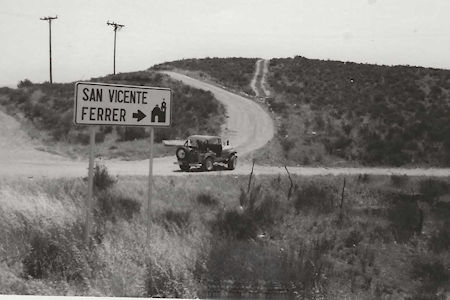
The crumbling adobe walls of Misión San Vicente Ferrer, once the largest Dominican outpost in Baja California, are located just 1/2 mile west of Highway 1 and only 52 miles south of Ensenada, thus enabling good accessibility to the ruins of this historic mission. Situated on a small plain above an arroyo, Misión San Vicente Ferrer was founded in 1780 by Padres Miguel Hidalgo and Joaquin Valero under the auspices of the Spanish Governor of the Californias, Felipe de Neve.
Problems developed almost immediately. At about the same time, hostile and aggressive Yuman Indians destroyed two missions on the Colorado River; the Franciscan padres there were killed along with entire families and all the livestock was driven off.
In the same attacks, Captain Rivera y Moncada, who led the advance party into Alta California for Gaspar de Portola and Padre Junipero Serra, was killed.
The fledgling mission of San Vicente Ferrer remained in a constant state of alarm as the adjacent arroyo led into the interior and was only a two-day journey up and across the Sierra Juarez. The strategic location did attract occasional, less successful raids.
For this reason, the governor made San Vicente a headquarters presidio and thick walls and lookout towers were added. As many as 30 soldiers quartered there at one time to help protect all of the northern missions. It served as the capital and administrative center of the California frontier up until 1849. It is sometimes referred to as the “old capital.”
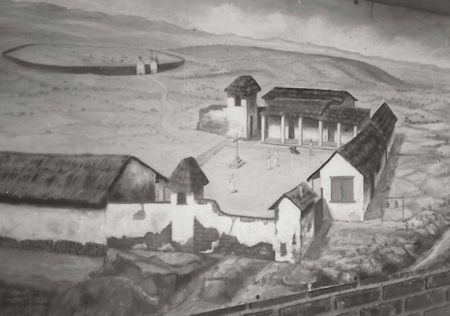
The existing foundation and remaining walls indicate a large area of buildings, and some of the ruins delineate the presidio and extensive Indian dwellings. The buildings were mostly made of adobe and featured gable roofs fashioned from reeds and palm fronds.
Less than a year after the mission was established a severe epidemic of smallpox left many dead. Padre Luis Sales replaced Father Hidalgo in October 1781 and set about reviving the mission. He buried the dead and rounded up starving Indians to house them at the mission.
After the epidemic, Sales captured two Yuman Indian spies sent to scout the area. He reported that he sent them far away from their own country, and thus reported the mission was spared another attack from the Indians.
Padre Sales later became known as the chief chronicler of the Dominican era in Baja California. He wrote three long letters to a friend in his hometown of Valencia, Spain in which he described the history of the Baja California peninsula, the missions, and the lifestyles of the native peoples.
The letters were later published into a book, “Observations on California, 1772-1790.” Sales provided indispensable information about traditional subsistence activities, religion, and many other matters. He also wrote that he despaired of the Indians’ “natural inclination toward certain vices” and their disinterest in attending confession and communion.
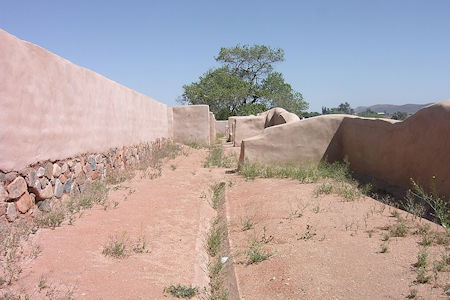
Regardless of the clash of cultures, at its peak in 1787 the San Vicente population was 317 Indians and slightly over 200 acres were cultivated. Due to the Mexican Secularization Act of 1833, the mission was abandoned, and by 1835 the San Vicente population was listed as 176.
The small garrison of troops remained at the presidio there until 1849 when they were transferred to Santo Tomás. After the secularization, the 17,000 acres surrounding the mission site were initially granted to José Matias Moreno.
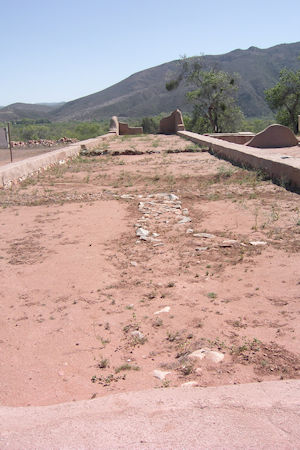
In early 1854 William Walker and his riotous band captured Ensenada and, with no soldiers to deter them, moved the capital of their newly established Republic of Lower California down to San Vicente.
In March 1854, Walker tried to cross the desert to take over Sonora but lost most of his troops to suffering, thirst, and abandonment. He returned to San Vicente to learn most of the small force he left there had deserted, and those who did not were killed by the Mexican army. After about four months of hostile occupancy, Walker returned to the states with his erstwhile army, sadder but wiser.
Because of Walker’s depravations and other civil disorders, the San Vicente population in 1855 was reduced to 40 people. The next year four families were listed as living there, eking out their subsistence from the land.
By 1867 San Vicente was reported to be all but uninhabited and Señor Manuel Clemente Rojo purchased the San Vicente Ranch, then composed of 5,266.85 hectares (about 13,000 acres) from the federal government. Originally from Peru, Rojo settled several families on the southern end, reintroduced livestock, planted fruit trees, vines, and various crops. Rojo also served as Sub-Jefe Politico of La Frontera from 1868 to 1873. He later sold most of the land to the Mexican Land and Colonization Company, Ltd. which established a colony of mostly Germans. By 1891 only 20 colonists remained.
By 1971, the San Vicente area population had reached 4,000 people.
Today, the rich earth of the San Vicente plain has given birth to a small, busy farming center with a population of over 6,000. It is the first town of any size past Ensenada and 22 miles past the village of Santo Tomás.
There are a couple of gas stations, some lodging facilities, several restaurants, and a town square which also hosts outdoor shopping stalls on weekends. There’s also a post office, tire repair, a hardware store and even a used car lot. On the west side of the town square is a small museum of Indian artifacts and local history. San Vicente also has a State Tourism office.
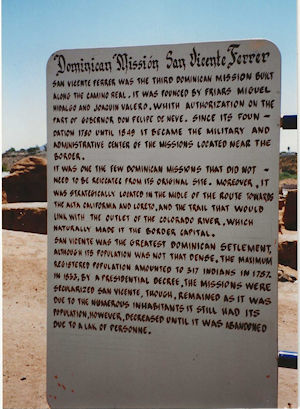
The mission ruins are on a rise over the riverbed, about 1/2 mile north of the plain upon which the current town rests. There is an old cemetery to the right on a little mesa that leads down to the mission. To the left on the same mesa is the foundation of the presidio, located where the Spanish garrison had a good view in all directions.
During the 1990s, the Baja California Mission Committee of the INAH (Instituto Nacional de Antropologia y Historia) made the mission an archeological dig, uncovering many partial walls and footings. They also made new adobe bricks to partially restore some of the walls, and an adobe-colored plaster coating was applied to preserve and waterproof the walls.
New thatched roof coverings, and cyclone fencing was placed to surround the area. Misión San Vicente is today more like a park, with visitor facilities, delineated gravel walkways, and more welcoming grounds. You can usually find a staff person at the site who can offer a brief tour.
They have also placed an informational sign in both Spanish and English near the ruins and an architectural rendering of the completed mission on a wall of an adjacent rest area. In addition, a directional sign was placed on the main highway. This historic site is still pastoral and mostly deserted. Its isolation belies its importance for almost 70 years as the headquarters for the entire northern Baja California area.
Marquis McDonald, who visited the Misión San Vicente in 1949, wrote, “It was very prosperous, noted for its fine gardens, vineyards and hospitality to the traveler. Now cacti grow rampant in the former gardens, and cattle graze peacefully among the debris. This was the largest mission we had seen to date and seemed to have been little disturbed.
“We were always depressed in the presence of these forlorn old ruins; and especially here, a dismal spirit seemed to permeate the surroundings, as a strong breeze soughed through the remaining walls like a mournful funeral dirge, adding to the effect.”

I had an awesome experience with Baja Bound. Family owned and highly personal, top notch customer...

Michelle is so efficient and thorough.

I've been a Baja Bound Insurance customer since 2006! They're the absolute best. #slowbajaapproved